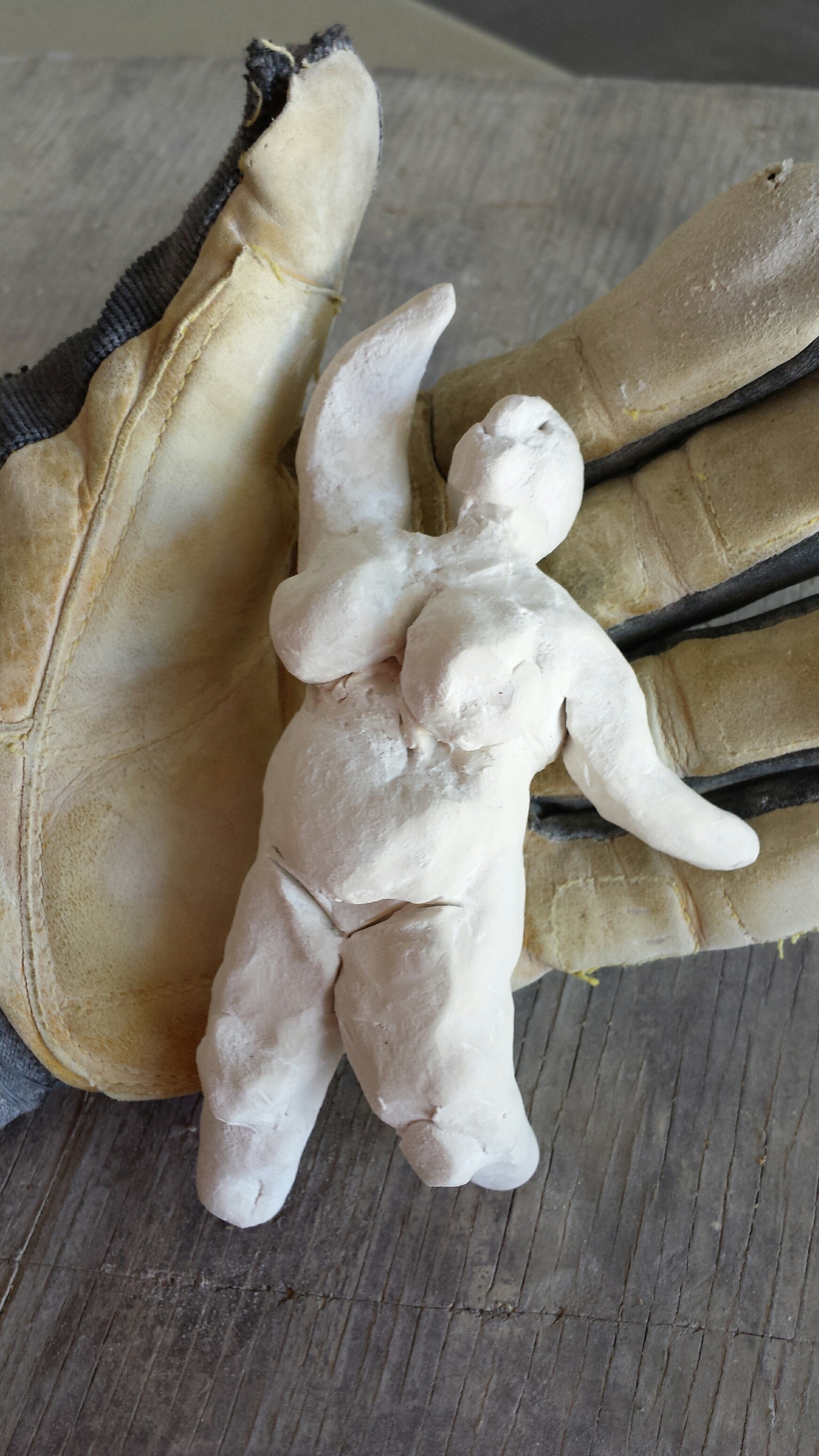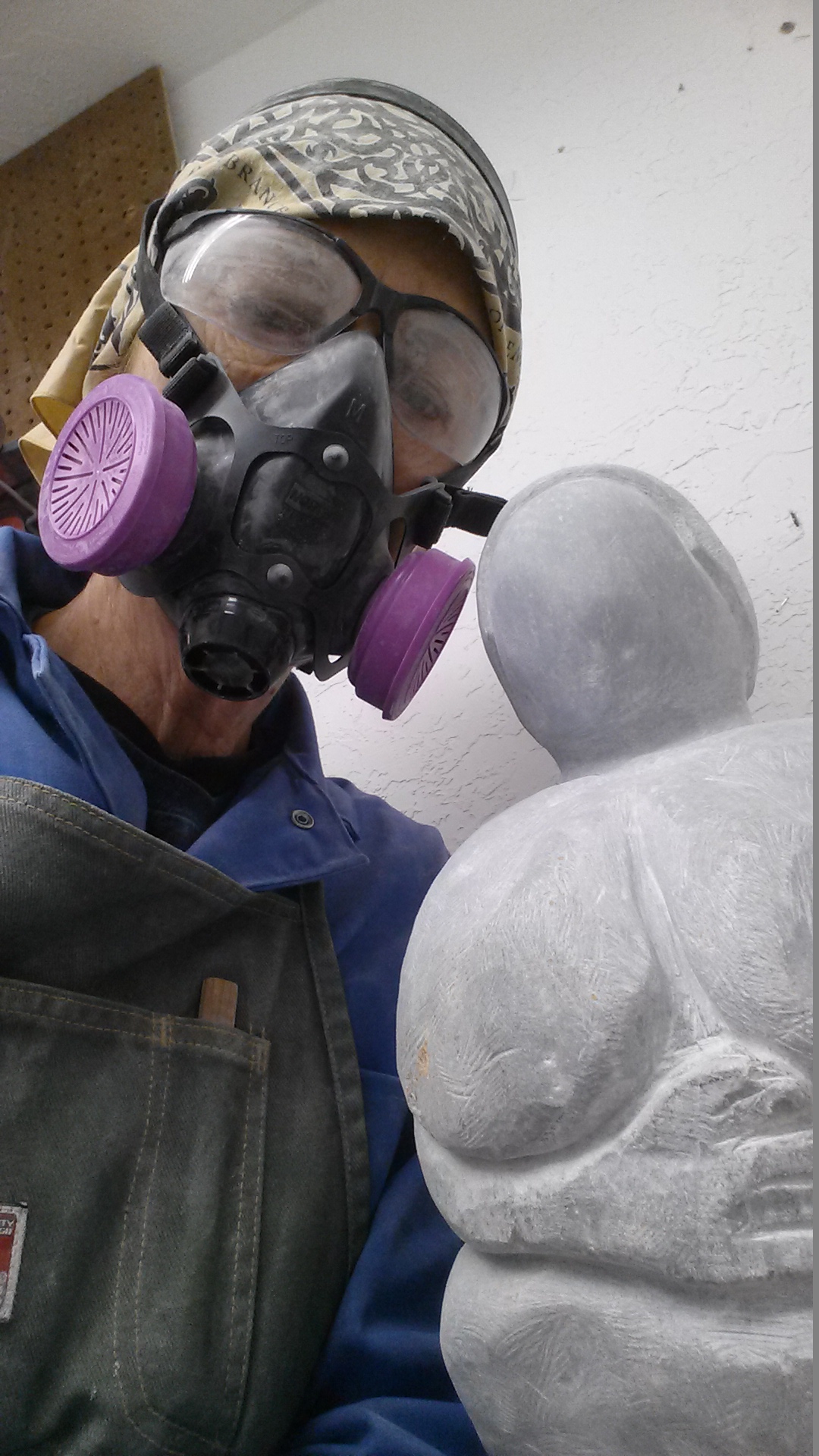Venus in Two Views for the Fat Phobia Gallery Show
By Jonna Ramey (All photos by Jonna Ramey)
The Venus of Willendorf is an iconic Paleolithic image of woman. To anyone familiar with the female body, this small sculpture is not a fertility goddess per se, she is young and she is fat. Gloriously, unabashedly fat. Roughly 4.5” tall, she was carved from oolitic limestone 28,000 to 25,000 years BCE.

As a feminist, this figurine has spoken to me for decades. She is a primal, strong, personal image of women—fat women. As a direct stone sculptor, I have both yearned for and shied away from the possibility of making my own Paleolithic figurines. Recently, for the exhibition Fat Phobia shown at Art Access Gallery in Salt Lake City, I carved two stone Venus figurines, but on a larger scale. My works are each approximately two feet high, carved in African or Utahan stone. One piece is my fairly literal take on the Venus of Willendorf, the second is a more abstract portrait. Together, they frame a conversation on body image and celebrate large women’s bodies from earliest humans to our present society.
‘Venus at Middle Age’ reflects on the Willendorf figure, envisioning her as a woman a few decades older. Older, wiser, still strong and vibrant. Of the two sculptures, I carved her first, using a piece of Zimbabwean opalstone.
I started the process by studying all the images I could find of the original Willendorf figurine online. The figurine has been photographed in many angles through the years and the source material was rich. Studying these images, I came to some personal conclusions and observations. First, the original sculptor loved his subject. Yes, I think the Venus of Willendorf was carved by a man and he was smitten. He loved her breasts, her vulva, her fat, her youth. But he posed her with her face cast down or hidden, and he rendered her arms as a late afterthought. To survive 28,000 years ago, a woman needed strong arms and she needed to look directly at the world. My sculpture, I decided, would show her in a different light.
Sketching on paper, I found I was creating an older, more mature woman. Her breasts would have fallen with age, and her arms would hold them up to relieve pressure on her back. She would look out at us, but like the original, her face is not detailed, making her everywoman. Her hair thinned with age, her hairline receding. While I roughed in a shape (a cocoon really) in the stone, I also worked on a small Sculpey maquette. Clearly, my sculpture was not going to be a replica of the figurine. I worked the stone entirely with hand tools in some quirky homage to the maker of the original. She was hand-sanded to 2000 grit and finished with Butcher’s wax. The piece took about 120 hours to complete.
‘V Kicks Up Her Heels’ imagines the woman who may have inspired the original Venus figurine in a playful manner. From the beginning, I knew she would be sculpted with Utah onyx (honeycomb calcite) to provide a strong counterpoint to the opaque blue-green opalstone. Honeycomb calcite’s translucency and vibrant color dictated that the sculpture could not incorporate subtle or fine detailing. It would have to be created with bolder gesturing. Where ‘Venus at Middle Age’ had a solid, composed dignity to her, ‘V…’ was always an active, dancing figure in my mind. A quickly composed maquette led me in a direction, but the stone had other ideas and I was willing to compromise. Instead of both arms flung out akimbo, one was raised and the other just dropped by her side. One leg is planted on the ground, though we only see the thigh, and the other leg is kicked back. Honeycomb calcite does not take hammer and chisel well. This piece was created using angle and die grinders. Finishing included diamond pad hand-sanding followed by buffing out with Italian Craftsman Polish. This piece took half the time of the other to produce.
The exhibition Fat Phobia was the brainchild of artist Carol Berrey and was curated by her and Sheryl Gillian, Executive Director of Art Access. Fat Phobia has been a great success. The opening drew 400 people. The audience was receptive to all the work shown, discussing the pieces, asking each other questions, commenting. Connected to the exhibit has been a series of talks and workshops ranging from author Jasmin Singer speaking on ‘Body Positivity’ to a writers’ workshop and subsequent poetry reading in the gallery. All events were well-attended. High school and college art students have paraded through the exhibit to look at the art, complete onsite assignments and then talk about body image and art. And, the artists have met each other, spoken about what they do and the content of their work.
 For an in depth critique of the show, go to Scotti Hill’s article in 15 Bytes e-magazine.
For an in depth critique of the show, go to Scotti Hill’s article in 15 Bytes e-magazine.For me personally, these two pieces have pushed my work into new realms. Exploring a playful, active form has kindled an interest in making more active figures in stone. The physical sculpting has for some reason made me more fearless when approaching a stone. And as a Euro-American woman, it’s been empowering to artistically embrace my paleo roots. How this all plays out in my sculpture… we’ll see. But, it’s given my work a fresh perspective and verve that is personally appreciated.
I sculpt stone. It gets me up in the morning. Every day. My work is often abstract, sometimes figurative but rarely literal. Making sculpture is a way for me to examine thoughts, emotions, cultural concerns, myths and taboos. I live and work in Salt Lake City, Utah.
